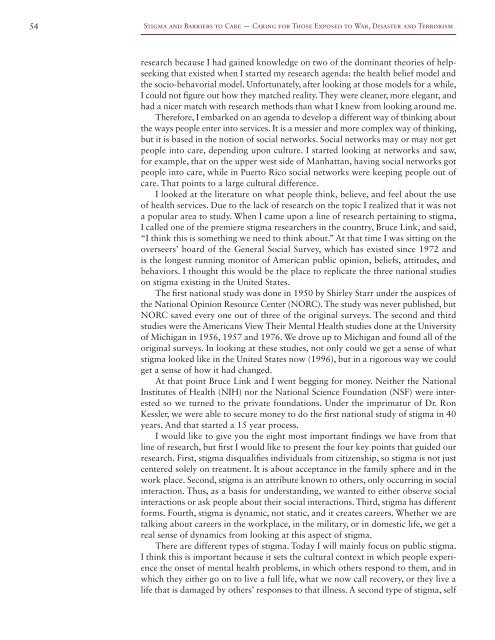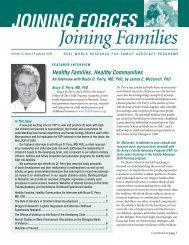stigma and barriers to care - Uniformed Services University of the ...
stigma and barriers to care - Uniformed Services University of the ...
stigma and barriers to care - Uniformed Services University of the ...
You also want an ePaper? Increase the reach of your titles
YUMPU automatically turns print PDFs into web optimized ePapers that Google loves.
54<br />
Stigma <strong>and</strong> Barriers <strong>to</strong> Care — Caring for Those Exposed <strong>to</strong> War, Disaster <strong>and</strong> Terrorism<br />
research because I had gained knowledge on two <strong>of</strong> <strong>the</strong> dominant <strong>the</strong>ories <strong>of</strong> helpseeking<br />
that existed when I started my research agenda: <strong>the</strong> health belief model <strong>and</strong><br />
<strong>the</strong> socio-behavorial model. Unfortunately, after looking at those models for a while,<br />
I could not figure out how <strong>the</strong>y matched reality. They were cleaner, more elegant, <strong>and</strong><br />
had a nicer match with research methods than what I knew from looking around me.<br />
Therefore, I embarked on an agenda <strong>to</strong> develop a different way <strong>of</strong> thinking about<br />
<strong>the</strong> ways people enter in<strong>to</strong> services. It is a messier <strong>and</strong> more complex way <strong>of</strong> thinking,<br />
but it is based in <strong>the</strong> notion <strong>of</strong> social networks. Social networks may or may not get<br />
people in<strong>to</strong> <strong>care</strong>, depending upon culture. I started looking at networks <strong>and</strong> saw,<br />
for example, that on <strong>the</strong> upper west side <strong>of</strong> Manhattan, having social networks got<br />
people in<strong>to</strong> <strong>care</strong>, while in Puer<strong>to</strong> Rico social networks were keeping people out <strong>of</strong><br />
<strong>care</strong>. That points <strong>to</strong> a large cultural difference.<br />
I looked at <strong>the</strong> literature on what people think, believe, <strong>and</strong> feel about <strong>the</strong> use<br />
<strong>of</strong> health services. Due <strong>to</strong> <strong>the</strong> lack <strong>of</strong> research on <strong>the</strong> <strong>to</strong>pic I realized that it was not<br />
a popular area <strong>to</strong> study. When I came upon a line <strong>of</strong> research pertaining <strong>to</strong> <strong>stigma</strong>,<br />
I called one <strong>of</strong> <strong>the</strong> premiere <strong>stigma</strong> researchers in <strong>the</strong> country, Bruce Link, <strong>and</strong> said,<br />
“I think this is something we need <strong>to</strong> think about.” At that time I was sitting on <strong>the</strong><br />
overseers’ board <strong>of</strong> <strong>the</strong> General Social Survey, which has existed since 1972 <strong>and</strong><br />
is <strong>the</strong> longest running moni<strong>to</strong>r <strong>of</strong> American public opinion, beliefs, attitudes, <strong>and</strong><br />
behaviors. I thought this would be <strong>the</strong> place <strong>to</strong> replicate <strong>the</strong> three national studies<br />
on <strong>stigma</strong> existing in <strong>the</strong> United States.<br />
The first national study was done in 1950 by Shirley Starr under <strong>the</strong> auspices <strong>of</strong><br />
<strong>the</strong> National Opinion Resource Center (NORC). The study was never published, but<br />
NORC saved every one out <strong>of</strong> three <strong>of</strong> <strong>the</strong> original surveys. The second <strong>and</strong> third<br />
studies were <strong>the</strong> Americans View Their Mental Health studies done at <strong>the</strong> <strong>University</strong><br />
<strong>of</strong> Michigan in 1956, 1957 <strong>and</strong> 1976. We drove up <strong>to</strong> Michigan <strong>and</strong> found all <strong>of</strong> <strong>the</strong><br />
original surveys. In looking at <strong>the</strong>se studies, not only could we get a sense <strong>of</strong> what<br />
<strong>stigma</strong> looked like in <strong>the</strong> United States now (1996), but in a rigorous way we could<br />
get a sense <strong>of</strong> how it had changed.<br />
At that point Bruce Link <strong>and</strong> I went begging for money. Nei<strong>the</strong>r <strong>the</strong> National<br />
Institutes <strong>of</strong> Health (NIH) nor <strong>the</strong> National Science Foundation (NSF) were interested<br />
so we turned <strong>to</strong> <strong>the</strong> private foundations. Under <strong>the</strong> imprimatur <strong>of</strong> Dr. Ron<br />
Kessler, we were able <strong>to</strong> secure money <strong>to</strong> do <strong>the</strong> first national study <strong>of</strong> <strong>stigma</strong> in 40<br />
years. And that started a 15 year process.<br />
I would like <strong>to</strong> give you <strong>the</strong> eight most important findings we have from that<br />
line <strong>of</strong> research, but first I would like <strong>to</strong> present <strong>the</strong> four key points that guided our<br />
research. First, <strong>stigma</strong> disqualifies individuals from citizenship, so <strong>stigma</strong> is not just<br />
centered solely on treatment. It is about acceptance in <strong>the</strong> family sphere <strong>and</strong> in <strong>the</strong><br />
work place. Second, <strong>stigma</strong> is an attribute known <strong>to</strong> o<strong>the</strong>rs, only occurring in social<br />
interaction. Thus, as a basis for underst<strong>and</strong>ing, we wanted <strong>to</strong> ei<strong>the</strong>r observe social<br />
interactions or ask people about <strong>the</strong>ir social interactions. Third, <strong>stigma</strong> has different<br />
forms. Fourth, <strong>stigma</strong> is dynamic, not static, <strong>and</strong> it creates <strong>care</strong>ers. Whe<strong>the</strong>r we are<br />
talking about <strong>care</strong>ers in <strong>the</strong> workplace, in <strong>the</strong> military, or in domestic life, we get a<br />
real sense <strong>of</strong> dynamics from looking at this aspect <strong>of</strong> <strong>stigma</strong>.<br />
There are different types <strong>of</strong> <strong>stigma</strong>. Today I will mainly focus on public <strong>stigma</strong>.<br />
I think this is important because it sets <strong>the</strong> cultural context in which people experience<br />
<strong>the</strong> onset <strong>of</strong> mental health problems, in which o<strong>the</strong>rs respond <strong>to</strong> <strong>the</strong>m, <strong>and</strong> in<br />
which <strong>the</strong>y ei<strong>the</strong>r go on <strong>to</strong> live a full life, what we now call recovery, or <strong>the</strong>y live a<br />
life that is damaged by o<strong>the</strong>rs’ responses <strong>to</strong> that illness. A second type <strong>of</strong> <strong>stigma</strong>, self




